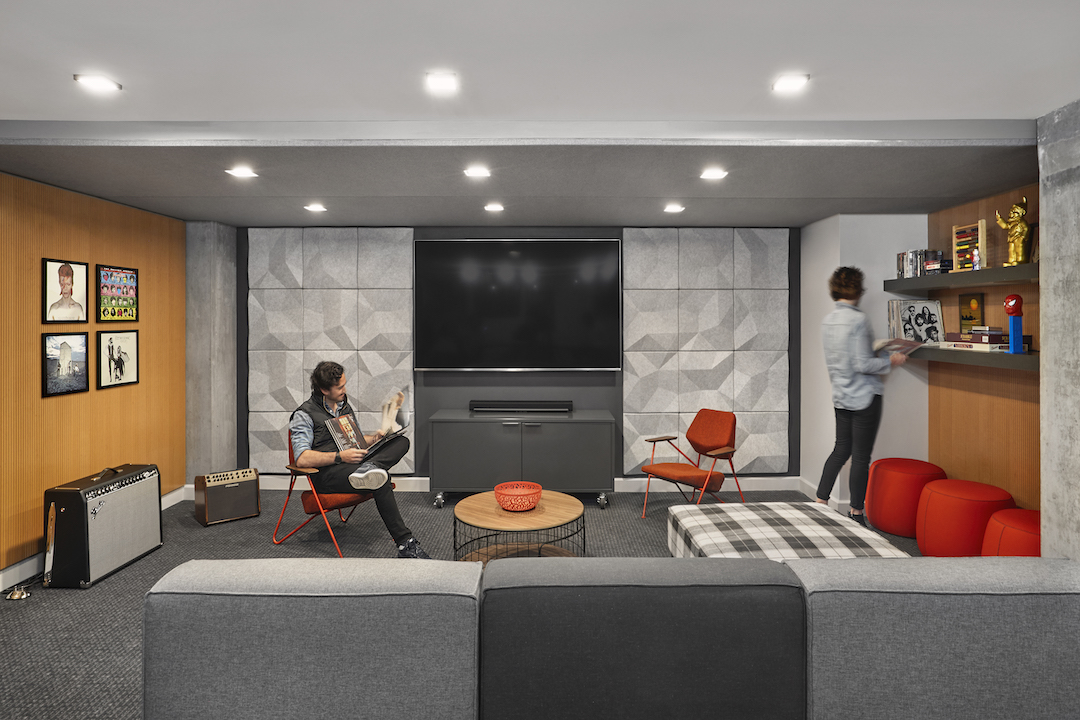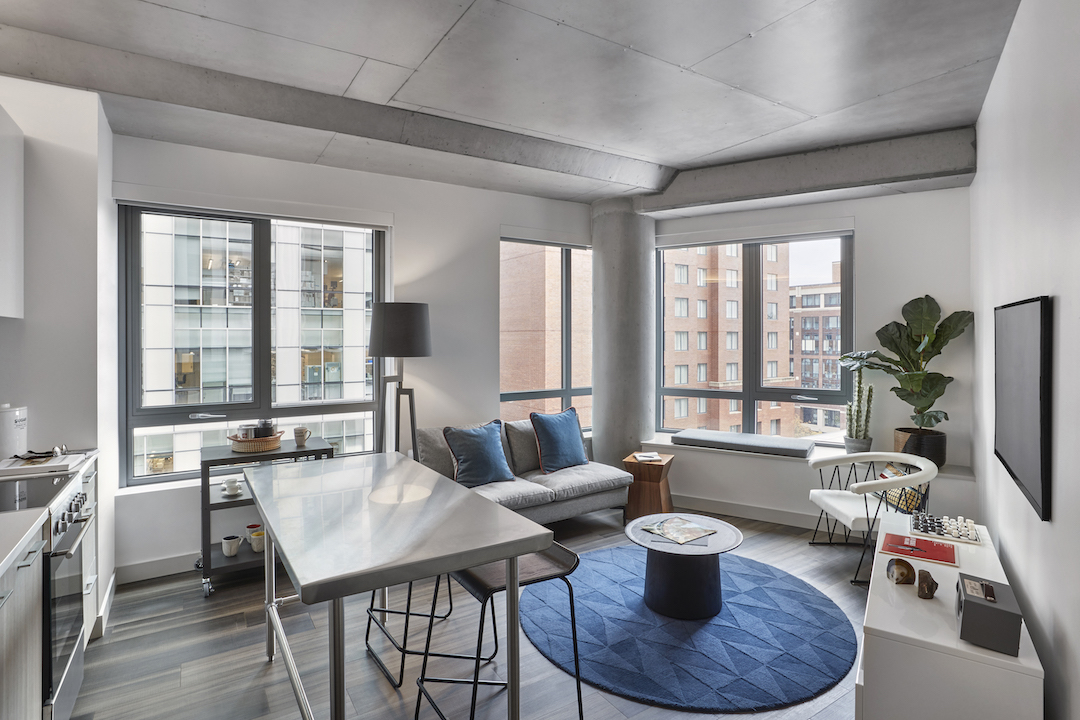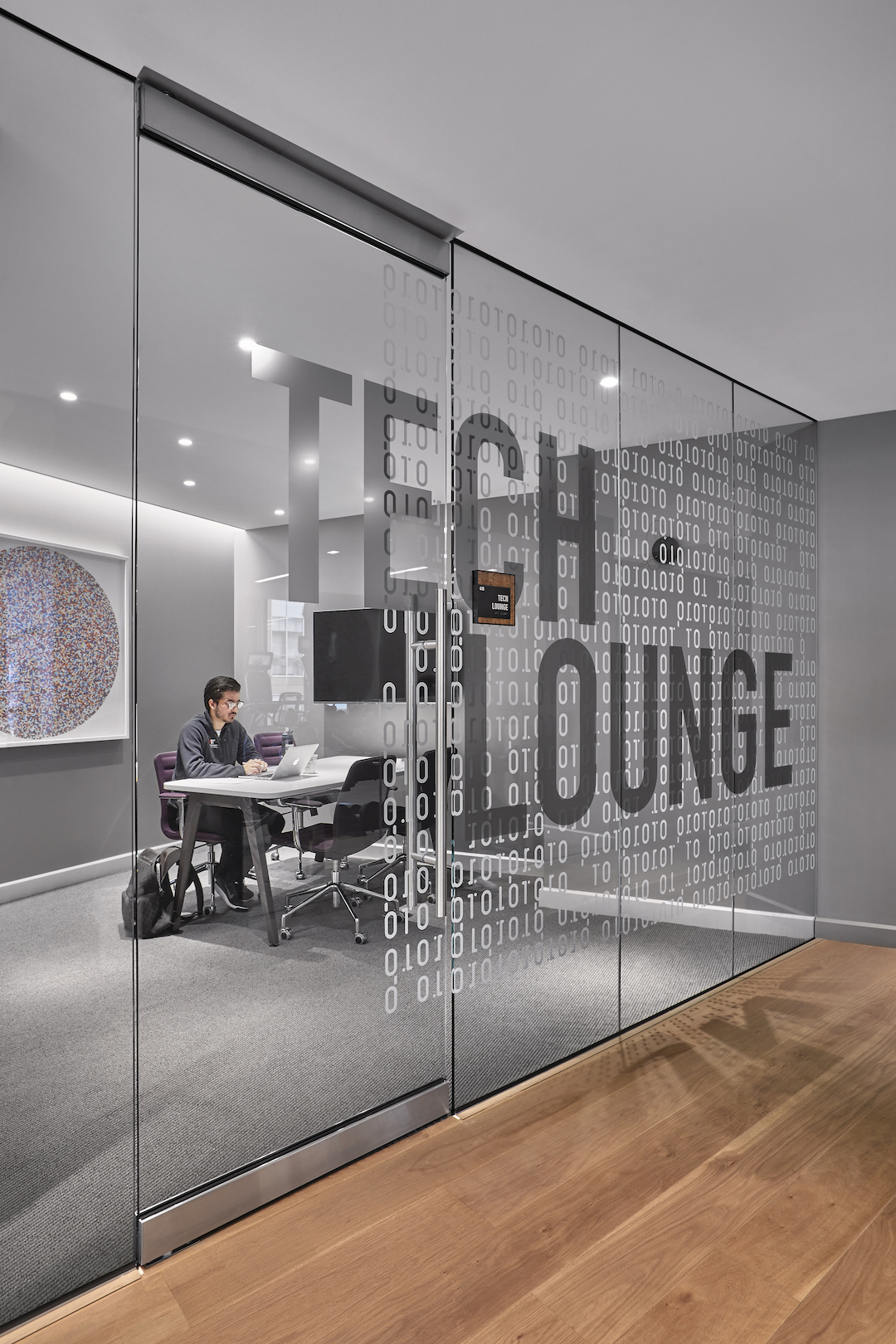A shortage of rental housing in the bustling Kendall Square neighborhood of Cambridge, Mass.—a hub of top-tier universities, research centers, and tech companies—prompted the development of Proto Kendall Square.
Boston Properties commissioned the 22-story, 280-unit apartment tower to help diversify the neighborhood’s office-centric property mix and expand its own multifamily portfolio. “We wanted to demonstrate the value of bringing high-quality rental property to a part of the city where we control a lot of commercial property,” said Boston Properties Project Manager Keir Evans.
Design architect FXCollaborative was tapped to develop the concept for a striking landmark on Ames Street, a minor access road that leads to two parking garages and a loading dock. Located within walking distance of dozens of tech employers and institutions, the site is served by the MBTA Red Line (known as the “Brain Train” for its role in transporting students to and from Harvard and MIT).
 The Garage, a cozy space where residents can hook up an electric guitar, play video games on a big-screen TV, or just kick back and enjoy the kitschy pop culture artwork.
The Garage, a cozy space where residents can hook up an electric guitar, play video games on a big-screen TV, or just kick back and enjoy the kitschy pop culture artwork.
The new structure had to fit within a tight triangular parcel which was formed by razing part of an existing parking garage and narrowing the street to create a bike lane and improve the pedestrian experience.
The goal: “to create a building that had presence, but was respectful of its dense context,” said Gustavo Rodriguez, AIA, LEED AP, Partner and Design Director at FXCollaborative in New York. “We had to strike a delicate balance between providing a sense of openness and a sense of privacy, both for tenants and for the surrounding offices.”
See Also: Eight projects showcase the latest trends in student housing
The design firm specified precast panels and punched windows to give the façade varying levels of transparency at different sections of the structure, informed by the proximity of that section to adjacent office buildings. Larger windows at the corners provide residents with scenic views of the Charles River and Boston skyline. “The building is constantly at play as you move around it, opening and closing to balance privacy and access to natural light and air,” said Rodriguez.
 A typical Proto apartment, 36 of which are classified as affordable. Unit amenities include Nest smart thermostats, ELFA closets, Thermofoil kitchen cabinets, keyless FOB entry, and operable windows.
A typical Proto apartment, 36 of which are classified as affordable. Unit amenities include Nest smart thermostats, ELFA closets, Thermofoil kitchen cabinets, keyless FOB entry, and operable windows.
At ground level, Proto features a modest pass-through lobby and four street-facing retail spaces occupied by a Mediterranean restaurant, coffee shop, florist, and bank.
The mix of the apartments is heavily studio (145 units) and one-bedroom units (90), appealing to the neighborhood’s sizable population of graduate students and millennial STEM workers. There are 43 two-bedroom units and a pair of three-bedroom apartments designed with families in mind. Thirteen percent of the units have been set aside to provide affordable housing.
DESIGNING FOR ‘THE SMARTEST PEOPLE IN THE WORLD’
“Thinking about where the smartest people in the world want to live was a really interesting design challenge,” said Colleen Arria, Principal at Stantec Architecture’s Boston office, which served as architect of record and interior designer. “Because the site was so tight, we had to be incredibly smart about how we planned every square inch of space.”
As you might expect, Proto’s apartments and common spaces integrate high-tech amenities, from smart thermostats to blazing-fast WiFi.
But the design team also created several high-touch amenity spaces that provide opportunities for residents to interact.
 Proto’s third-floor lounge serves as a communal living room for the micro-units on that floor. All residents enjoy 24-hour concierge and ButterflyMX entry system, a dedicated package room with Luxor management system, video gaming systems, a fireside lounge, a communal kitchen, a fitness center, a yoga and spin studio, and a pet spa with dog run.
Proto’s third-floor lounge serves as a communal living room for the micro-units on that floor. All residents enjoy 24-hour concierge and ButterflyMX entry system, a dedicated package room with Luxor management system, video gaming systems, a fireside lounge, a communal kitchen, a fitness center, a yoga and spin studio, and a pet spa with dog run.
The third level houses compact studio apartments and several lounge and co-working areas. It features a unique laundry lounge that doubles as a social space where residents can play board games or watch TV.
The fourth level has a large kitchen that opens to a communal living room area with a ping-pong table and outdoor terrace. Other amenities: a fitness center with a yoga and spin studio, a pet spa, and an adjacent dog run.
The fourth level also offers “The Garage,” a cozy multipurpose space reminiscent of a basement rec room suitable for a replay of “Bill and Ted’s Excellent Adventure.” Initially envisioned as a storage area due to its low ceilings and lack of windows, the space was reconfigured into a casual hideaway where residents could express their creativity.
“As we’ve designed other urban residences for highly educated communities, we’ve found these folks appreciate having a place where they can express themselves—by playing instruments, crafting, or building models—in an environment where they can get messy and not disturb other people,” said Stantec’s Arria.

Throughout the residential community, Proto’s modern, upscale design aesthetic incorporates comfy furniture and an abundance of exposed concrete. Other design elements pay homage to Kendall Square’s rich history—its early connections to NASA, ongoing leadership in the biotech industry, and historic role as a global center of research and innovation. A custom-made rug is emblazoned with excerpts from President John F. Kennedy’s legendary speech on the national role of space exploration.
“The design is really steeped in this idea of science, science fiction, and fantasy—with nods to pop culture icons from Star Wars to David Bowie,” said Timothy Reagen, LEED AP BD+C, Designer/Manager at Stantec. “To us, these elements just resonated with the idea of exploration into the infinite possibilities that science has to offer.”
Built at a cost of $108.7 million, Proto Kendall Square opened in June 2018 and achieved 97% occupancy in its first year of operation.
“It’s garnering the highest per-square-foot rent in the city right now, with a lease renewal rate of over 50%, which is reassuring that the environment that we created is successful and well recieved by residents," said Evans.
Related Stories
| Mar 22, 2011
Mayor Bloomberg unveils plans for New York City’s largest new affordable housing complex since the ’70s
Plans for Hunter’s Point South, the largest new affordable housing complex to be built in New York City since the 1970s, include new residences for 5,000 families, with more than 900 in this first phase. A development team consisting of Phipps Houses, Related Companies, and Monadnock Construction has been selected to build the residential portion of the first phase of the Queens waterfront complex, which includes two mixed-use buildings comprising more than 900 housing units and roughly 20,000 square feet of new retail space.
| Mar 17, 2011
Perkins Eastman launches The Green House prototype design package
Design and architecture firm Perkins Eastman is pleased to join The Green House project and NCB Capital Impact in announcing the launch of The Green House Prototype Design Package. The Prototype will help providers develop small home senior living communities with greater efficiency and cost savings—all to the standards of care developed by The Green House project.
| Mar 11, 2011
Renovation energizes retirement community in Massachusetts
The 12-year-old Edgewood Retirement Community in Andover, Mass., underwent a major 40,000-sf expansion and renovation that added 60 patient care beds in the long-term care unit, a new 17,000-sf, 40-bed cognitive impairment unit, and an 80-seat informal dining bistro.
| Mar 11, 2011
Mixed-income retirement community in Maryland based on holistic care
The Green House Residences at Stadium Place in Waverly, Md., is a five-story, 40,600-sf, mixed-income retirement community based on a holistic continuum of care concept developed by Dr. Bill Thomas. Each of the four residential floors houses a self-contained home for 12 residents that includes 12 bedrooms/baths organized around a common living/social area called the “hearth,” which includes a kitchen, living room with fireplace, and dining area.
| Mar 11, 2011
Texas A&M mixed-use community will focus on green living
HOK, Realty Appreciation, and Texas A&M University are working on the Urban Living Laboratory, a 1.2-million-sf mixed-use project owned by the university. The five-phase, live-work-play project will include offices, retail, multifamily apartments, and two hotels.
| Mar 1, 2011
How to make rentals more attractive as the American dream evolves, adapts
Roger K. Lewis, architect and professor emeritus of architecture at the University of Maryland, writes in the Washington Post about the rising market demand for rental housing and how Building Teams can make these properties a desirable choice for consumer, not just an economically prudent and necessary one.
| Feb 15, 2011
New Orleans' rebuilt public housing architecture gets mixed reviews
The architecture of New Orleans’ new public housing is awash with optimism about how urban-design will improve residents' lives—but the changes are based on the idealism of an earlier era that’s being erased and revised.
| Feb 11, 2011
Chicago high-rise mixes condos with classrooms for Art Institute students
The Legacy at Millennium Park is a 72-story, mixed-use complex that rises high above Chicago’s Michigan Avenue. The glass tower, designed by Solomon Cordwell Buenz, is mostly residential, but also includes 41,000 sf of classroom space for the School of the Art Institute of Chicago and another 7,400 sf of retail space. The building’s 355 one-, two-, three-, and four-bedroom condominiums range from 875 sf to 9,300 sf, and there are seven levels of parking. Sky patios on the 15th, 42nd, and 60th floors give owners outdoor access and views of Lake Michigan.
| Feb 11, 2011
Sustainable community center to serve Angelinos in need
Harbor Interfaith Services, a nonprofit serving the homeless and working poor in the Harbor Area and South Bay communities of Los Angeles, engaged Withee Malcolm Architects to design a new 15,000-sf family resource center. The architects, who are working pro bono for the initial phase, created a family-centered design that consolidates all programs into a single building. The new three-story space will house a resource center, food pantry, nursery and pre-school, and administrative offices, plus indoor and outdoor play spaces and underground parking. The building’s scale and setbacks will help it blend with its residential neighbors, while its low-flow fixtures, low-VOC and recycled materials, and energy-efficient mechanical equipment and appliances will help it earn LEED certification.
| Feb 11, 2011
Apartment complex caters to University of Minnesota students
Twin Cities firm Elness Swenson Graham Architects designed the new Stadium Village Flats, in the University of Minnesota’s East Bank Campus, with students in mind. The $30 million, six-story residential/retail complex will include 120 furnished apartments with fitness rooms and lounges on each floor. More than 5,000 sf of first-floor retail space and two levels of below-ground parking will complete the complex. Opus AE Group Inc., based in Minneapolis, will provide structural engineering services.















